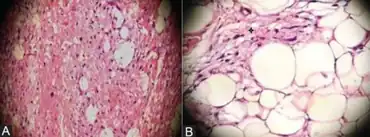Neural fibrolipoma
| Neural fibrolipoma | |
|---|---|
 | |
| a,b) Lesion is composed of uniform appearing adipocytes with strands of spindle cells star | |
Neural Fibrolipoma is an overgrowth of fibro-fatty tissue along a nerve trunk that often leads to nerve compression.[1][2] These only occur in the extremities, and often affect the median nerve. They are rare, very slow-growing, and their origin is unknown.[3] It is believed that they may begin growth in response to trauma. They are not encapsulated by any sort of covering or sheath around the growth itself, as opposed to other cysts beneath the skin that often are. This means there are loosely defined margins of this lipoma. Despite this, they are known to be benign. Neural fibrolipomas are often more firm and tough to the touch than other lipomas. They are slightly mobile under the skin, and compress with pressure.
Signs and symptoms
Individuals with lipofibromatous hamartoma present with enlarging lesions, and may have neurologic symptoms of the affected nerve, as well as numbness and tingling[4]
Diagnosis
Neural fibrolipomas are often characterized by a mass under the skin accompanied with sensory deficit in the same area or a painful sensation. There is often loss of motor function in the hand as well. These lipomas are almost exclusively found in people under 30 years old.[5] The mass is made of fibro-fatty tissue that begins encroaches on a nerve. Surgery is often needed to relieve pressure. Some common nerves that are affected are the median, ulnar, radial, perineal, and brachial plexus. Macrodactyly occurs in around two thirds of cases.[6] Taking a biopsy of the mass is not necessary because these are distinct enough to make a confident diagnosis only from the use of medical imaging, like an MRI. However, if a biopsy is taken, it will show an abundance of mature fat cells surrounded by fibrous connective tissue.[7] Neural fibrolipomas are often associated with carpal tunnel syndrome, due to both of their correlation with the median nerve. To diagnose this as a neural fibrolipoma, Tinel’s sign and the Phalen maneuver are used to show signs of nerve sensitivity and distress on the median nerve. This, alongside imaging, can accurately diagnose these rare growths.
Treatment
Surgery is often needed to remove the neural fibrolipoma. The surgeon often treats the mass as if it is carpal tunnel syndrome and does a carpal tunnel release.[8] This surgery is paired with neurolysis and a partial excision of the neural fibrolipoma. In some cases, they may think an entire excision is possible. They would then begin by decompressing the nerve, and then working to excise the fatty growth, which is easily distinguishable from the nerve. Because of surgery in such close proximity to the median nerve, permanent sensory or motor dysfunction can occur, so surgery is not always the suggested mode of treatment.
Terminology
Other names for Neural fibrolipoma are:[9]
- Neural lipofibromatous hamartoma
- Fibrolipomatous hamartoma of the nerve
- Lipomatosis of the nerve
- Fibrolipomatosis of the nerve
- Neurolipomatosis
See also
References
- ↑ WHO Classification of Tumours Editorial Board, ed. (2020). "1. Soft tissue tumours: Lipomatosis of nerve". Soft Tissue and Bone Tumours: WHO Classification of Tumours. Vol. 3 (5th ed.). Lyon (France): International Agency for Research on Cancer. pp. 18–19. ISBN 978-92-832-4503-2.
- ↑ James, William; Berger, Timothy; Elston, Dirk (2005). Andrews' Diseases of the Skin: Clinical Dermatology. (10th ed.). Saunders. ISBN 0-7216-2921-0.
- ↑ Kim, You Jeong; Kim, Si-Yong; Kang, Seok Jin; Kim, Gyoung Moon (2005-09-01). "Neural fibrolipoma". Journal of the American Academy of Dermatology. 53 (3): 527–528. doi:10.1016/j.jaad.2005.01.122. ISSN 0190-9622. PMID 16112370. Archived from the original on 2022-04-20. Retrieved 2021-06-15.
- ↑ "Lipofibromatous Hamartoma Clinical Presentation: History and Physical Examination". emedicine.medscape.com. Archived from the original on 20 April 2022. Retrieved 19 April 2022.
- ↑ "WebPathology". webpathology.com. Archived from the original on 2021-03-04. Retrieved 2021-04-06.
- ↑ Ulrich, Dietmar; Ulrich, Franziska; Schroeder, Michael; Pallua, Norbert (2008-07-10). "Lipofibromatous hamartoma of the median nerve in patients with macrodactyly: diagnosis and treatment of a rare disease causing carpal tunnel syndrome". Archives of Orthopaedic and Trauma Surgery. 129 (9): 1219–1224. doi:10.1007/s00402-008-0695-6. ISSN 0936-8051. PMID 18615252. S2CID 29699976. Archived from the original on 2022-04-20. Retrieved 2021-06-15.
- ↑ Tahiri, Youssef; Xu, Liqin; Kanevsky, Jonathan; Luc, Mario (2013-10-01). "Lipofibromatous Hamartoma of the Median Nerve: A Comprehensive Review and Systematic Approach to Evaluation, Diagnosis, and Treatment". The Journal of Hand Surgery. 38 (10): 2055–2067. doi:10.1016/j.jhsa.2013.03.022. ISSN 0363-5023. PMID 23684521. Archived from the original on 2022-04-20. Retrieved 2021-06-15.
- ↑ Louaste, Jamal; Zejjari, Hassan; Chkoura, Mohamed; Houmadi, Aziz; Rachid, Khalid (2011). "Carpal tunnel syndrome due to fibrolipomatous hamartoma of the median nerve". Hand (New York, N.Y.). 6 (1): 76–79. doi:10.1007/s11552-010-9290-8. ISSN 1558-9447. PMC 3041878. PMID 22379443.
- ↑ "Neural Fibrolipoma - Surgical Pathology Criteria - Stanford University School of Medicine". surgpathcriteria.stanford.edu. Archived from the original on 2021-01-26. Retrieved 2021-04-06.